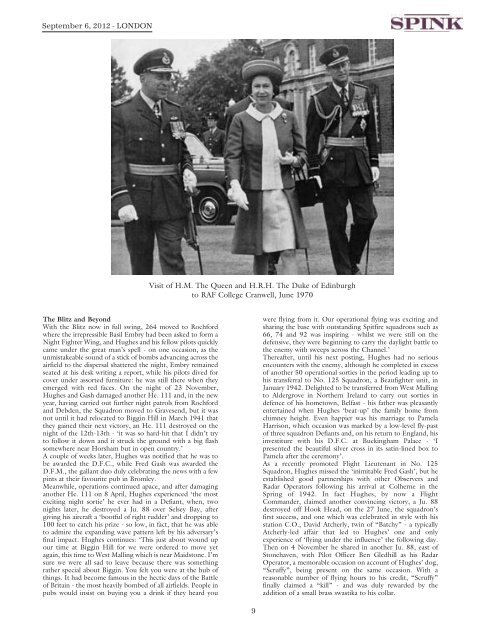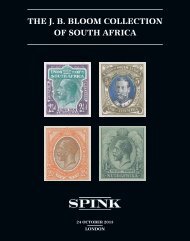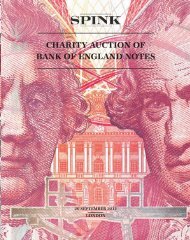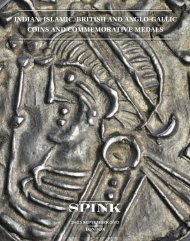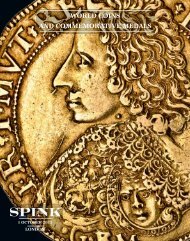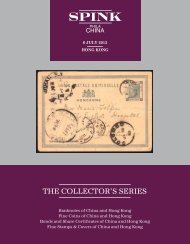bentley priory - Spink
bentley priory - Spink
bentley priory - Spink
You also want an ePaper? Increase the reach of your titles
YUMPU automatically turns print PDFs into web optimized ePapers that Google loves.
September 6, 2012 - LONDON<br />
Visit of H.M. The Queen and H.R.H. The Duke of Edinburgh<br />
to RAF College Cranwell, June 1970<br />
The Blitz and Beyond<br />
With the Blitz now in full swing, 264 moved to Rochford<br />
where the irrepressible Basil Embry had been asked to form a<br />
Night Fighter Wing, and Hughes and his fellow pilots quickly<br />
came under the great man’s spell - on one occasion, as the<br />
unmistakeable sound of a stick of bombs advancing across the<br />
airfield to the dispersal shattered the night, Embry remained<br />
seated at his desk writing a report, while his pilots dived for<br />
cover under assorted furniture: he was still there when they<br />
emerged with red faces. On the night of 23 November,<br />
Hughes and Gash damaged another He. 111 and, in the new<br />
year, having carried out further night patrols from Rochford<br />
and Debden, the Squadron moved to Gravesend, but it was<br />
not until it had relocated to Biggin Hill in March 1941 that<br />
they gained their next victory, an He. 111 destroyed on the<br />
night of the 12th-13th - ‘it was so hard-hit that I didn’t try<br />
to follow it down and it struck the ground with a big flash<br />
somewhere near Horsham but in open country.’<br />
A couple of weeks later, Hughes was notified that he was to<br />
be awarded the D.F.C., while Fred Gash was awarded the<br />
D.F.M., the gallant duo duly celebrating the news with a few<br />
pints at their favourite pub in Bromley.<br />
Meanwhile, operations continued apace, and after damaging<br />
another He. 111 on 8 April, Hughes experienced ‘the most<br />
exciting night sortie’ he ever had in a Defiant, when, two<br />
nights later, he destroyed a Ju. 88 over Selsey Bay, after<br />
giving his aircraft a ‘bootful of right rudder’ and dropping to<br />
100 feet to catch his prize - so low, in fact, that he was able<br />
to admire the expanding wave pattern left by his adversary’s<br />
final impact. Hughes continues: ‘This just about wound up<br />
our time at Biggin Hill for we were ordered to move yet<br />
again, this time to West Malling which is near Maidstone. I’m<br />
sure we were all sad to leave because there was something<br />
rather special about Biggin. You felt you were at the hub of<br />
things. It had become famous in the hectic days of the Battle<br />
of Britain - the most heavily bombed of all airfields. People in<br />
pubs would insist on buying you a drink if they heard you<br />
were flying from it. Our operational flying was exciting and<br />
sharing the base with outstanding Spitfire squadrons such as<br />
66, 74 and 92 was inspiring - whilst we were still on the<br />
defensive, they were beginning to carry the daylight battle to<br />
the enemy with sweeps across the Channel.’<br />
Thereafter, until his next posting, Hughes had no serious<br />
encounters with the enemy, although he completed in excess<br />
of another 50 operational sorties in the period leading up to<br />
his transferral to No. 125 Squadron, a Beaufighter unit, in<br />
January 1942. Delighted to be transferred from West Malling<br />
to Aldergrove in Northern Ireland to carry out sorties in<br />
defence of his hometown, Belfast - his father was pleasantly<br />
entertained when Hughes ‘beat-up’ the family home from<br />
chimney height. Even happier was his marriage to Pamela<br />
Harrison, which occasion was marked by a low-level fly-past<br />
of three squadron Defiants and, on his return to England, his<br />
investiture with his D.F.C. at Buckingham Palace - ‘I<br />
presented the beautiful silver cross in its satin-lined box to<br />
Pamela after the ceremony’.<br />
As a recently promoted Flight Lieutenant in No. 125<br />
Squadron, Hughes missed the ‘inimitable Fred Gash’, but he<br />
established good partnerships with other Observers and<br />
Radar Operators following his arrival at Colherne in the<br />
Spring of 1942. In fact Hughes, by now a Flight<br />
Commander, claimed another convincing victory, a Ju. 88<br />
destroyed off Hook Head, on the 27 June, the squadron’s<br />
first success, and one which was celebrated in style with his<br />
station C.O., David Atcherly, twin of “Batchy” - a typically<br />
Atcherly-led affair that led to Hughes’ one and only<br />
experience of ‘flying under the influence’ the following day.<br />
Then on 4 November he shared in another Ju. 88, east of<br />
Stonehaven, with Pilot Officer Ben Gledhill as his Radar<br />
Operator, a memorable occasion on account of Hughes’ dog,<br />
“Scruffy”, being present on the same occasion. With a<br />
reasonable number of flying hours to his credit, “Scruffy”<br />
finally claimed a “kill” - and was duly rewarded by the<br />
addition of a small brass swastika to his collar.<br />
9


